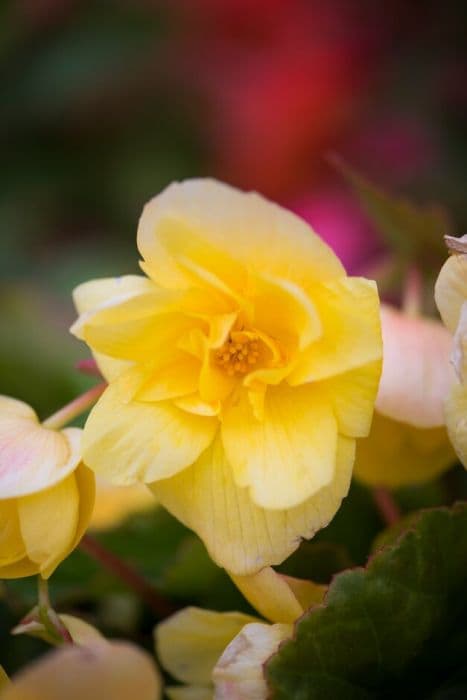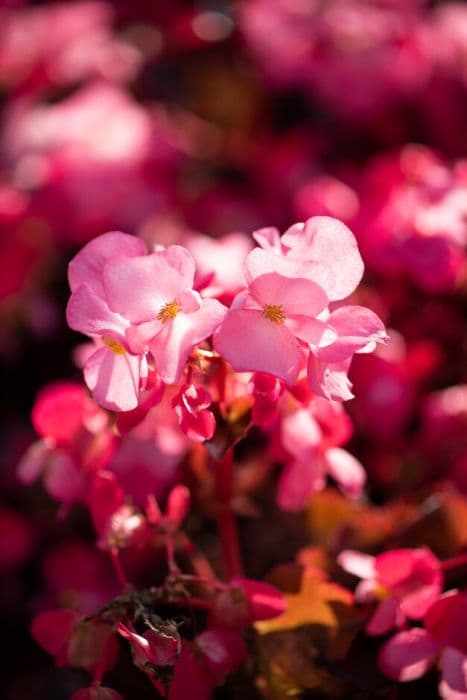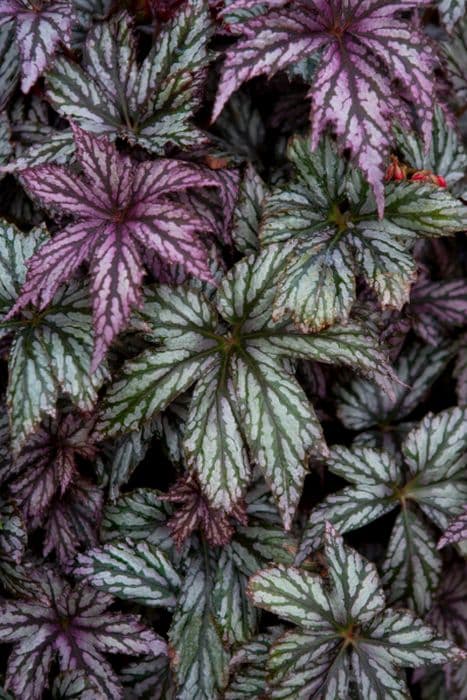Helen Lewis Begonia Begonia 'Helen Lewis' (R)

ABOUT
Begonia 'Helen Lewis' is a charming plant that boasts a lush, green foliage consisting of heart-shaped leaves with a glossy texture that exhibit a rich and deep green color. The leaves may also have red or burgundy undersides, which create a delightful contrast against the green top surfaces. The defining feature of this particular begonia are its striking flowers, which come in a vivacious shade of orange. The flowers are typically large and showy with ruffled petals that add to their ornate appearance. These blossoms are borne in clusters above the foliage, creating a captivating display that can easily become a focal point in any garden or room. The overall form of the plant is typically bushy and well-branched, which allows the foliage and flowers to spread neatly and create a full, lush appearance.
About this plant
 Names
NamesFamily
Begoniaceae
Synonyms
Helen Lewis Begonia, Helen Lewis Fancy-leaf Begonia
Common names
Begonia 'Helen Lewis'
 Toxicity
ToxicityTo humans
Begonias, including the 'Helen Lewis' variety, contain insoluble oxalates, which can be mildly toxic when ingested. If someone eats part of a begonia, they may experience symptoms such as a burning sensation in the mouth, lips, tongue, and throat, as well as difficulty swallowing and nausea. In extreme cases, vomiting and diarrhea can also occur. It's important to promptly consult a healthcare professional if ingestion occurs and symptoms develop.
To pets
Begonias are also toxic to pets due to the presence of insoluble oxalates. If pets consume parts of a begonia, they may exhibit signs of poisoning such as irritation and burning of the mouth, lips, and tongue, increased salivation, difficulty swallowing, and vomiting. In severe cases, ingestion can lead to more serious gastrointestinal issues. Pet owners should contact a veterinarian immediately if their pet has ingested part of a begonia plant.
 Characteristics
CharacteristicsLife cycle
Perennials
Foliage type
Deciduous
Color of leaves
Variegated
Flower color
Orange
Height
1 foot (30 cm)
Spread
2 feet (60 cm)
Plant type
Herb
Hardiness zones
10
Native area
Central and South America
Benefits
 General Benefits
General Benefits- Ornamental value: Begonia 'Helen Lewis' adds aesthetic appeal to gardens, patios, and indoor spaces with its attractive foliage and vibrant blooms.
- Low maintenance: This variety typically requires minimal care, making it ideal for busy individuals or those new to gardening.
- Shade tolerance: It can thrive in shaded areas where many other flowering plants might struggle, providing color in dimly lit spaces.
- Long blooming period: 'Helen Lewis' often enjoys a lengthy flowering season, offering extended visual interest compared to other plants.
- Versatility: It can be grown in a variety of settings, such as containers, hanging baskets, or in mixed borders, providing flexibility in garden design.
- Propagation ease: Begonias can be easily propagated from cuttings, leaf cuttings or division, enabling gardeners to create more plants for use in other areas or to share with friends.
- Diverse foliage: Begonia 'Helen Lewis' features unique and varied leaf shapes and patterns, which remain attractive even when the plant is not in bloom.
- Compact growth: The plant is well-suited for small spaces due to its controlled growth habit, making it ideal for apartment living and small gardens.
 Medical Properties
Medical PropertiesThis plant is not used for medical purposes.
 Air-purifying Qualities
Air-purifying QualitiesThis plant is not specifically known for air purifying qualities.
 Other Uses
Other Uses- Begonia 'Helen Lewis' can be utilized in terrariums due to its small size and ability to adapt to high humidity environments.
- The contrasting foliage of Begonia 'Helen Lewis' can serve as a living art piece, creating a natural tapestry when grown on a moss wall or vertical garden.
- As an educational tool in botany classes, Begonia 'Helen Lewis' can help students learn about plant care, propagation, and hybridization processes.
- Used in corsages and boutonnieres, the vibrant flowers of the Begonia 'Helen Lewis' add a unique touch to formal attire for special events.
- Begonia 'Helen Lewis' plants can be used as a natural dye source, where the flowers and leaves produce delicate colors on fabrics.
- Its leaves can be incorporated into creative craft projects, including leaf casting or eco-printing on paper for artistic designs.
- During festive seasons, Begonia 'Helen Lewis' can be used as a natural and attractive table centerpiece or part of a floral arrangement.
- The petals of Begonia 'Helen Lewis' are edible and can be used to add a splash of color to salads or as an edible decoration on cakes and desserts.
- Begonia 'Helen Lewis' can be grown as part of a themed garden, such as a Victorian or fairy garden, enhancing the aesthetic with its quaint charm.
- In photography, Begonia 'Helen Lewis' can be used as a vibrant subject or background for macro photography, showcasing the intricate details of flowers and foliage.
Interesting Facts
 Feng Shui
Feng ShuiThe Begonia is not used in Feng Shui practice.
 Zodiac Sign Compitability
Zodiac Sign CompitabilityThe Begonia is not used in astrology practice.
 Plant Symbolism
Plant Symbolism- Beware: Begonias are often associated with caution or a warning to be wary. The 'Helen Lewis' begonia may carry this symbolism, perhaps as a gentle reminder to be mindful of one's surroundings or the company one keeps.
- Gratitude: These plants can also symbolize deep appreciation and thankfulness. Gifting a 'Helen Lewis' begonia could express your heartfelt gratitude toward someone.
- Individuality: With its unique appearance, the begonia might represent being unique or standing out from the crowd. The 'Helen Lewis' variety, with its distinctive flowers, underscores this meaning.
- Unconsciousness: In the language of flowers, begonias can sometimes be connected to deeper, unconscious thoughts or feelings. The 'Helen Lewis' might evoke an awareness of these inner processes.
 Water
WaterThe Begonia 'Helen Lewis', commonly known as the Rhizomatous Begonia, should be watered when the top inch of soil feels dry to the touch, roughly once a week, depending on environmental conditions. Use room temperature water and gently water the soil until it's moist but not saturated, avoiding wetting the leaves to prevent fungal diseases. In practice, this may mean providing about 8-16 ounces of water weekly, adjusting for climate and the plant's growth phase. During active growth in spring and summer, they may need more frequent watering, while in fall and winter, water less often as the plant requires.
 Light
LightRhizomatous Begonias like the 'Helen Lewis' prefer bright, indirect light. They thrive in east or west-facing windows where they receive filtered morning or afternoon sun, avoiding the harsh midday sun which can scorch their leaves. A spot that offers consistent light without direct exposure to the sun's rays is ideal for these plants.
 Temperature
TemperatureRhizomatous Begonias, such as 'Helen Lewis', do best in temperatures between 60 and 75 degrees Fahrenheit. They should not be exposed to temperatures below 50 degrees Fahrenheit, as cold temperatures can damage the plant. The ideal temperature range supports healthy growth and flowering throughout the year.
 Pruning
PruningPruning Rhizomatous Begonias like 'Helen Lewis' encourages bushier growth and should be done in spring or after flowering. Remove any dead or dying leaves and stems to promote air circulation and new growth. Pinch off the tips of stems to maintain a compact shape. Prune lightly, as over-pruning can stress the plant.
 Cleaning
CleaningAs needed
 Soil
SoilThe Begonia 'Helen Lewis' thrives best in a well-draining soil mix consisting of peat moss, perlite, and pine bark fines at a ratio of about 3:1:1. An ideal soil pH for this Begonia should be slightly acidic to neutral, around pH 6.0 to 7.0.
 Repotting
RepottingBegonias like 'Helen Lewis' typically need to be repotted every 1-2 years or when they become root-bound. Repotting in the spring is usually beneficial, as this is the start of their active growing season.
 Humidity & Misting
Humidity & MistingThe Begonia 'Helen Lewis' prefers a high humidity environment, typically between 50-70%. Regular misting or a pebble tray can help maintain these humidity levels.
 Suitable locations
Suitable locationsIndoor
Place in bright, indirect light and maintain high humidity for best growth.
Outdoor
Keep in dappled light and protect from extreme weather; water regularly.
Hardiness zone
6-11 USDA
 Life cycle
Life cycleThe Begonia 'Helen Lewis' begins its life as a seed, and upon germination, it sprouts and produces small leaves. As it enters the vegetative stage, it develops a robust stem and more leaves, gradually maturing and increasing in size. During the blooming period, the Begonia 'Helen Lewis' produces vividly colored flowers, typically in the warmer months, depending on the climate it is grown in. After pollination, which can occur through natural agents like wind or insects, the plant will develop seed capsules if the flowers are fertilized. Once the seeds mature, they are dispersed from the capsules, and the plant may enter a dormant phase, especially in cooler climates or during adverse conditions. Finally, with the arrival of favorable growth conditions, such as the return of warmth and moisture, these seeds can begin the cycle anew, repeating the process for the speices' propagation and survival.
 Propogation
PropogationPropogation time
Spring-Early Summer
The Begonia 'Helen Lewis' can be propagated most effectively through stem cuttings, with the ideal time for this being spring or early summer when the plant is actively growing. To propagate from a stem cutting, select a healthy, non-flowering stem from the parent plant and cut a piece approximately 4 inches (10 centimeters) long, making sure there are at least a couple of leaves on the cutting. Remove the leaves from the lower half of the cutting to expose the nodes, as roots will develop from these nodes when in contact with the soil. Dip the cut end of the stem into rooting hormone to encourage root growth and place the stem cutting into a pot with moistened potting mix. Cover the pot with a clear plastic bag to create a greenhouse-like environment, which helps maintain humidity. Keep the pot in a warm place with indirect sunlight and after a few weeks, roots should develop, at which point you can remove the plastic cover and treat the new plant as you would a mature Begonia.



![Begonia [Bonfire]](/_next/image?url=https%3A%2F%2Fplants-admin.emdemapps.com%2Fimages%2Fplants%2F%2Fimages%2F604b6124363f0.png&w=640&q=75)


![Begonia [Devotion]](/_next/image?url=https%3A%2F%2Fplants-admin.emdemapps.com%2Fimages%2Fplants%2F%2Fimages%2F604b58183573b.png&w=640&q=75)


